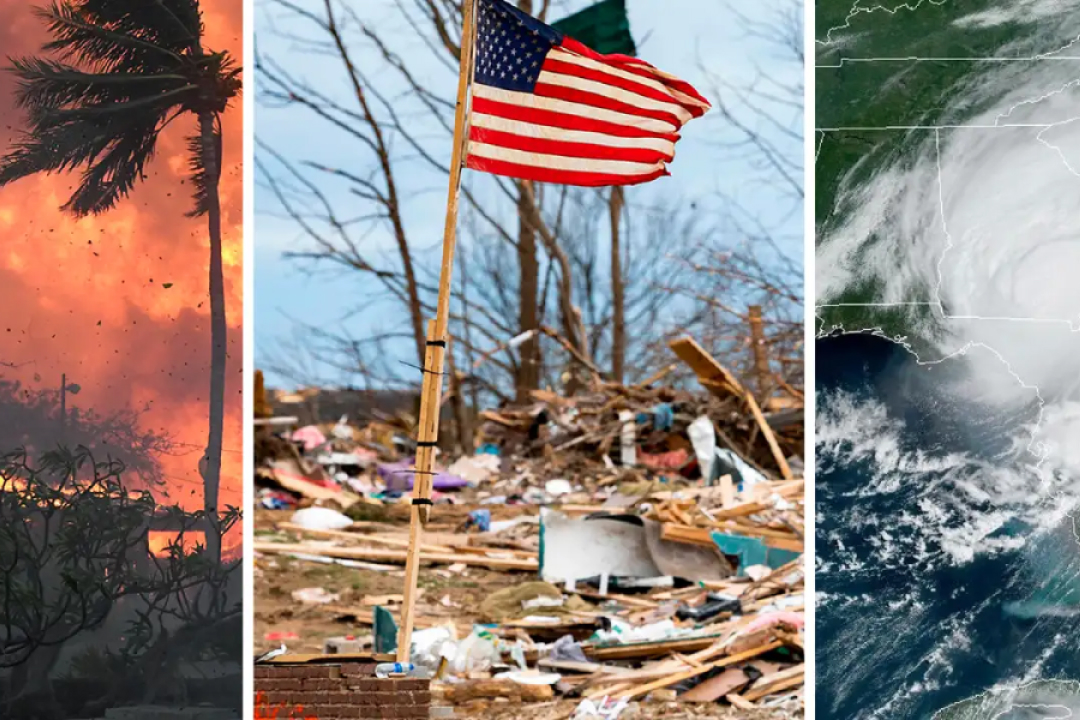
If budgets are the government’s attempt to chart the course for the next few years, what can this one teach us about how climate change is leaving its mark and how the government plans to tackle it?
The U.S. experienced a record 28 billion-dollar weather and climate disasters in 2023, part of a rising trend in disaster frequency and costs.
According to NOAA, in 2023, the U.S. government spent approximately $92.9 billion on natural disaster recovery. This figure is based on the cost of 28 separate billion-dollar weather and climate disasters that occurred throughout the year. These events included severe weather, flooding, tropical cyclones, tornadoes, a winter storm, a wildfire, and a significant drought and heatwave.
The increasing number and severity of such events highlight the escalating financial burden on federal disaster assistance programs, emphasizing the need for enhanced mitigation and adaptation strategies to manage future risks more effectively.
Nationwide, tropical cyclones are the most costly type of billion-dollar disaster, and severe storms are the most frequent. Each U.S. region faces a different set of disaster risks each season.

It’s difficult to measure precisely how much climate change has already impacted federal budgets globally, but some key figures provide insight. The most obvious indicator is the amount countries currently spend on disaster recovery payments.
Climate change and global climate action will profoundly impact the global economy, reshaping the mix of industries and requiring effective mitigation and adaptation to manage climate impacts.
The U.S. government is expected to spend significant amounts on natural disaster recovery in the coming years. For Fiscal Year 2024, the Federal Emergency Management Agency (FEMA) has estimated a requirement of approximately $19.47 billion for major disasters.
Additionally, the Government Accountability Office (GAO) highlights that the increasing frequency and severity of natural disasters are driving up the reliance on federal disaster assistance. Since 1980, weather and climate disasters have caused trillions of dollars in damage, necessitating a substantial federal response to support recovery efforts and build resilience (USGAO).
These projections underscore the escalating financial burden on the federal government to address the impacts of natural disasters, further emphasizing the need for effective mitigation and adaptation strategies.
Once confined to scientific publications, climate scenarios are now central to sustainability discussions across various industries, from investors to the energy and food & beverage sectors. Companies like Apple and Ben & Jerry’s use climate scenarios for risk management. These scenarios are increasingly used due to their inclusion in global accounting and sustainability disclosure standards, such as IFRS, adopted in 168 countries. Companies identifying climate change as a financial risk are now required to use climate-related scenario assessments.
Recently, the US Fed conducted a pilot climate scenario assessment with six major banks, revealing that a hurricane event in the US Northeast could impact 20-50% of their residential and commercial real estate loans. Given that the value of commercial real estate loans in the US was nearly $3000 billion in March 2024, this potential impact is significant.
Climate scenarios and forecasts are often used interchangeably, but they are distinct. The IPCC (Intergovernmental Panel on Climate Change) emphasizes that climate scenarios are not forecasts; they are storylines of what the future could look like based on current knowledge, whereas forecasts are considered more likely outcomes.
Investors and companies in several countries are now encouraged to include climate scenarios in their sustainability disclosures. This practice was integrated into the IFRS standards, ensuring international comparability of financial and sustainability reporting. Businesses use these scenarios to assess risks and opportunities under different global warming scenarios, evaluating both physical and policy/technological risks.
However, there are limitations in how businesses use climate scenarios. Some companies use only one scenario, which contradicts the scientific view of multiple possible futures. For example, an analysis of companies reporting to the Carbon Disclosure Project revealed that about 14% use only a single scenario. Additionally, there is a need for more capacity building at the business level, as the skill is currently primarily found in large corporations.
Understanding and leveraging climate scenarios, combined with robust collaboration, can help better prepare for and mitigate the impacts of climate change, instilling confidence in our ability to handle climate uncertainties.
An analysis conducted by Deloitte shows that reaching net-zero emissions by 2050 requires urgent action, at roughly four times the speed of major historical transformations like the Industrial Revolution. Acting now to capture emissions is dramatically more effective than delaying; capturing 1 million metric tonnes per annum (mmtpa) of carbon by 2050 is equivalent to capturing only 0.35 mmtpa today. Despite a slowdown in the economy, global energy-related carbon dioxide emissions rose by 1.1% in 2023 compared to 2022, according to the International Energy Agency. Deloitte’s research highlights that each year of delay in reducing carbon emissions could result in as much as $150 billion in incremental costs.
Cross-sector collaboration and collective action are crucial for driving global impact and achieving net-zero emissions. Careful planning and coordination among industries are essential to realizing the highest impact in a relatively short timeframe.

I’ve spent the past 18+ years helping ports, supply chains, and global businesses turn sustainability goals into real, measurable results.
From leading billion-dollar infrastructure projects to building my own consulting firm, I’ve seen how the right strategy can turn pressure into opportunity.
My mission today is simple: help leaders like you build sustainable, future-ready businesses that don’t just check boxes—but actually make an impact. One decision, one project, one team at a time.
Let’s build what’s next—together.
Have a project or idea in mind?
I’d love to hear what you’re working on.
Book a quick call here